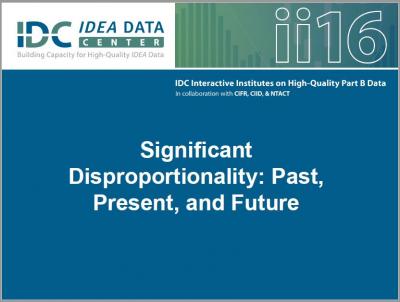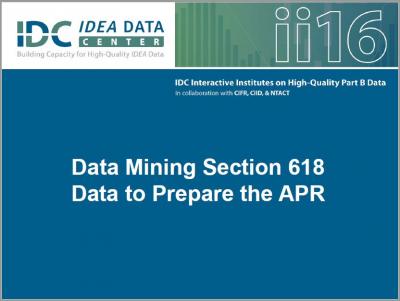Site Search
Results 1 - 7 of 11
Format: Presentations
New Significant Disproportionality Regulations WebinarThis webinar focused on key components of the new significant disproportionality regulations presented in §20 U.S.C. 1418(d) and 34 CFR §§300.646 and 300.647. The regulations require states to determine whether significant disproportionality based on race/ethnicity is occurring with respect to the identification of children as children with disabilities, including identification as children with particular impairments; placement of children in particular educational settings; and incidence, duration, and type of disciplinary actions, including suspensions and expulsions. Timeline for state compliance is July 1, 2018, and states must make significant disproportionality determinations using new methodology during SY 2018-19. The webinar highlighted new OSEP Significant Disproportionality Resources and included resources that comprise IDC's Disproportionality and Equity Resource Collection. The webinar was part of IDC's Discipline Peer-to-Peer Exchange.
Format: Presentations
Equity, Inclusion, and Opportunity: Creating Educational Systems That Meet the Needs of All Groups of StudentsMany schools and districts have been identified as low performing or disproportionate because of disparities between subgroups on a variety of success measures. Other schools and districts are proactively trying to address identified success gaps. Presenters from IDC demonstrated IDC's Success Gaps Toolkit that can help schools and districts 1) prepare all of their students for success in college and careers by addressing success gaps, 2) collect and use quantitative and qualitative data for the purpose of root-cause analysis of those success gaps, and 3) focus attention on those root causes for the benefit of children and students in the lowest performing subgroups.
Format: Presentations
Using Data to Explore and Prepare for Expected Changes to Significant Disproportionality: What Should Your State Be Thinking About?To address the disparities experienced by minority students with disabilities, the U.S. Department of Education is proposing a new Equity in IDEA Rule. During this session, presenters used data examples to guide states through a series of questions regarding how the Notice of Proposed Rule Making might affect significant disproportionality calculations, analysis, and decision-making. Presenters also introduced IDC’s Success Gaps Toolbox, which can help states and local school districts in determining root causes of significant disproportionality.
Format: Presentations
Significant Disproportionality: Past, Present, and FutureWith the U.S. Department of Education’s recent publication of an NPRM on Significant Disproportionality, questions abounded regarding what such a rule would mean for states and districts. This session began with a brief history of the statutes and regulations related to significant disproportionality. The majority of the session focused on the similarities and differences between the current regulation and the proposed rule and what effects these may have on states.
Format: Presentations
Data Mining Section 618 Data to Prepare the APRThe required measurements for APR Indicators B3, B4, B5, B6, B9, and B10 (the assessment, discipline, LRE, and disproportionality indicators) are based on Section 618 data. This session focused on selected section 618 data submissions and how the data can be explored to provide more in-depth information for use in discussion with state’s APR stakeholders. Presenters demonstrated some practical methods for taking a deeper look at data in the IDEA EDFacts file submissions using readily available data analysis tools (Microsoft Excel).
Format: Presentations
Equity, Inclusion, and Opportunity: Getting SSIP Results by Addressing Success GapsThe presentation provides a self-assessment rubric that can help states and local districts view their school/district programs and practices with an "equity" lens and help states and LEAs understand the reasons for discrepancies in outcomes between certain groups of students. Helpful handouts are included.
Format: Presentations
Identified Significant Disproportionality – Now What?After a State determines that a district has significant disproportionality, what are the next steps? Presenters and session participants discussed how states can identify technical assistance and available tools and resources to help LEAs identify root causes and implement action steps, including CEIS, to make substantive improvement.








